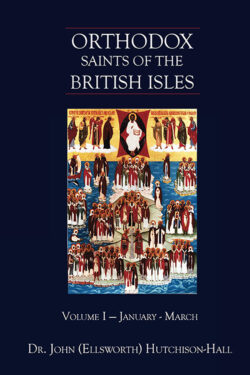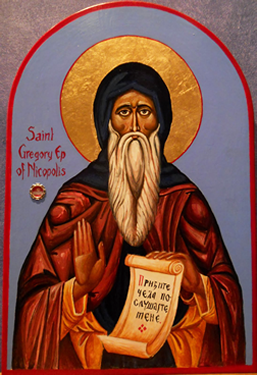
Orthodox Saints of the Pre-Schism
See of Rome
16th March (NS) — 3rd March (OS) 2024
ANSELM, a nobleman and brother-in-law of Aistulf, King of Lombards (r. 749–756). St. Anselm was a career soldier before he left the world and received monastic tonsure. He was the founder of abbeys in Fanano and Nonantola, near Modena in the Po Valley. Both monasteries had hospitals and hostels attached to them. St. Anselm served as Abbot of Nonantola, which grew to around one thousand monks. He reposed in 803.
ARTHELAIS, one of the patron-saints (along with SS. Barbatus 19th February, and Bartholomew the Apostle 11th June) of Benevento in Italy. St. Arthelais was the daughter of an imperial proconsul named Lucius and his wife Aithuesa and is said to have been pursued by Emperor Justinian I (r. 527–565). However, she had taken vows of chastity and fled to Benevento to escape the Emperor’s attentions. St. Arthelais reposed of a fever in 560.
CALUPAN, an anchorite who lived in a cave near Méallet in Auvergne. He reposed in 575.
CAMILLA, after being converted to Christianity by St. Germanus of Auxerre (31st July), St. Camilla became one of his disciples, finishing her life as an anchoress, reposing circa 437.
CELE-CHRIST, St. Cele-Christ (Worshipper of Christ) led an hermetic life for many years, before being forced to accept a bishopric in Leinster. According to The Annals of Ulster, he reposed 728. There is no further information on his life extant.
CUNEGUND, the wife of Emperor Henry II (r. 973–1024) and foundress of Kaufungen Abbey, near present-day Kassel Germany. following repose of Henry, St. Cunegund received monastic tonsure at Kaufungen where she spent the remaining fifteen years of her life, reposing in 1039.
EMETERIUS (HEMITERIUS) and CHELEDONIUS, (Fourth Century), two soldiers in the Imperial Roman army who were martyred in Calahorra in Old Castile, present-day Spain.
FELIX, LUCIOLUS, FORTUNATUS, MARCIA, and COMPANIONS, (Date Unknown), members of a group of forty martyrs in North Africa. The names of the rest of the group are no longer known.
FOILA (FAILE, FOILENNA, FALLENA), (Sixth Century), believed to have been the sister of St. Colgan (20th February), together they are the patrons of the parishes of Kil-Faile (Kileely) and Kil-Colgan, in Co. Galway. Kil-faile has been a noted place of pilgrimage. At one point, there was a written record of her life called The Acts of St. Foila, however, it is no longer extant.
LAMALISSE, a Scottish hermit for whom Lamlash on the Isle of Arran is named. No further information on St. Lamalisse is extant.
NON (NONNA, NONNITA), the mother of St. David of Wales (1st March). St. Non spent her later years in a monastery. She came to be renowned for such sanctity that, following her repose, churches were dedicated to her, including a chapel and well near her son’s cathedral at St. David’s in Pembrokeshire, and another in Altarnun, on the north-eastern edge of Bodmin Moor, in Cornwall. Though her relics were kept in Cornwall, some claim that she ended her days in Brittany. However, there is insufficient evidence to support this theory. The exact year of St. Non’s repose is unknown, though it must have been in the first half of the sixth century
SACER (MO-SACRA), (Seventh Century), an Irish Abbot-founder of the monastery of Saggard (Teach Sacra - 'house of Sacra' in Irish Gaelic) near Dublin in Ireland.
TITIAN, a Bishop of Brescia in Lombardy (northern Italy), of Germanic birth. St. Titian reposed circa 536.
WINWALOE, born in Brittany (north-western France) to English exiles, St. Winwaloe was related to SS. Cadfan (1st November), Selyf (25th June), and Cybi (8th November). He became a disciple of St. Budoc (9th December) on the Île Lavret. He went on to found the monastery at Landévennec, which he governed until his repose in the first quarter of the sixth century. There are several churches in Cornwall dedicated to him, indicating a connexion between him and that area. Unfortunately, there is no reliable Life known to us, and it is difficult to attempt to construct one from various traditions, many of which are contradictory. It is even possible that there may have been more than one saint of his name.
Get your copy of Orthodox Saints of the British Isles today.
Available at Amazon or your favourite e-bookstore.
ABBAN, (Fifth Century), a nephew of St. Ibar (23rd April), and contemporary of St. Patrick (17th March), St. Abban founded Kill-Abban Abbey in Leinster. No further information on this saint is extant.
AGAPITUS (AGAPETUS), a third or fourth century Bishop of Ravenna. There seem to have been two Bishops of Ravenna called Agapitus. One in the third century and the other in the fourth. Over time their lives have become conflated. It seems that the third century Agapitus is St. Agapitus, and the fourth century one has never been venerated as a saint. Of course, the paucity of reliable records makes it impossible to state with any certainty, which is which.
DENTLIN (DENTELIN, DENAIN), (Seventh Century), the son of St. Vincent Madelgarus (20th September) and St. Waldetrudis (9th April), and brother of SS. Landry (17th April), Adeltrudis (25th February), and Madalberta (7th September). Though only seven years old when he reposed, he has always been venerated as a saint with the rest of his family.
EUSEBIA, the eldest daughter of SS. Adalbald (2nd February) and Rictrudis (12th May); great-granddaughter of St. Gertrude the Elder (6th December); sister of SS. Maurontius (9th January), Clotsindis (30th June), and Adalsindis (25th December). When St. Eusebia was still quite young her father was murdered and her mother sent her to the Hamage Abbey (Abbaye d'Hamage), where her great-grandmother, St. Gertrude the Elder (6th December), was the founding abbess. when St. Gertrude reposed St. Eusebia was elected to succeed her, even though she was only twelve years of age. St. Rictrudis, realising that St. Eusebia did not have the experience to be an abbess, took over Hamage, merging it into her own Abbey of Marchiennes (later known as the Abbey of SS. Rictrude and Peter of Marchiennes / Abbaye Sainte-Rictrude et Saint-Pierre de Marchiennes). All the nuns were moved from Hamage to Marchiennes, resulting in a fair bit of dissent amongst the nuns from Hamage. In time St. Rictrudis blessed Hamage nuns return to Hamage with St. Eusebia as Abbess. The time at Marchiennes served St. Eusebia well, as she had grown in wisdom and spirituality. St. Eusebia served as the second Abbess of Hamage until her repose in 680.
FINIAN, a disciple of St. Columba of Iona (9th June), he is said to have been Abbot of Swords just north of Dublin. However, as is the case with many of his contemporaries, ascertaining the truth within the various and tangled traditions of his Life is impossible.
GREGORY MAKAR, an Armenian monk who was elected Bishop of Nicopolis in Armenia. Later he lived as a hermit in Pithiviers near Orleans, reposing circa 1000. St. Gregory Makar is credited with introducing gingerbread to Europe.
HERIBERT, son of Hugo, Duke of Worms, St. Heribert was educated at the Abbey of St. Gorgonius of Gorze (abbaye Saint-Gorgon de Gorze — Gorze Abbey). In 994, having completed his studies, St. Heribert was ordained to the priesthood, and made Provost of St. Peter’s Cathedral in Worms. In 999, St. Heribert was consecrated fourteenth Archbishop of Cologne. As Archbishop, St. Heribert founded a monastery and church at Deutz on the outskirts of Cologne. St. Heribert was honoured as a saint during his lifetime, a wonderworker his prayers ended a drought. St. Heribert reposed in 1021 and his relics were enshrined at the monastery he founded.
HILARY, TATIAN, FELIX, LARGUS, and DIONYSIUS, Hilary, Bishop of Aquileia, Tatian, his deacon, and three laymen, beheaded during the persecutions under Emperor Numerian (r. 283–284) circa 284.
MEGINGAUD (MENGOLD, MEGINGOZ), a monk and eventually Abbot at Fritzlar in present-day Hesse in Germany. In 754, St. Megingaud, was consecrated second Bishop of Würzburg. St. Megingaud resigned his See in 769 and retired to Neustadt am Main Abbey (Kloster Neustadt am Main). There he spent the next fourteen years in prayer. St. Megingaud reposed at Newstadt in 783.
Prior to the Schism the Patriarchate of Rome was Orthodox, and fully in communion with the Orthodox Church. As Saint John of Shanghai and San Francisco +1966 said “The West was Orthodox for a thousand years, and her venerable Liturgy is far older than any of her heresies”.
Details of British Saints excerpted from Orthodox Saints of the British Isles.
Details of continental saints from these sources.
In many cases there are several spelling versions of the names of saints from the British Isles. I use the Oxford Dictionary of National Biography version as the primary version with the more prevalent version in parenthesis e.g. Ceadda (Chad) of Lichfield.


